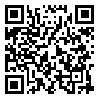Volume 2, Issue 3 (Spring 2011 -- 2011)
BCN 2011, 2(3): 51-57 |
Back to browse issues page
Download citation:
BibTeX | RIS | EndNote | Medlars | ProCite | Reference Manager | RefWorks
Send citation to:



BibTeX | RIS | EndNote | Medlars | ProCite | Reference Manager | RefWorks
Send citation to:
Narenjkar J, Roghani M, Alambeygi H, Sedaghati F. The Effect of the Flavonoid Quercetin on Pain Sensation in Diabetic Rats. BCN 2011; 2 (3) :51-57
URL: http://bcn.iums.ac.ir/article-1-146-en.html
URL: http://bcn.iums.ac.ir/article-1-146-en.html
Abstract:
Introduction:
Hyperalgesia is considered as one of the marked signs of subchronic diabetes mellitus in patients that could affect their lifestyle. This study was designed to investigate the anti-nociceptive effect of chronic administration of quercetin in streptozotocin (STZ)-diabetic rats using formalin and hot tail immersion tests.Methods:
Rats were divided into control, control or diabetic groups receiving sodium salicylate, untreated diabetic, and quercetin-treated control and diabetic groups. The treatment groups received i.p. administration of quercetin at a dose of 10 mg/kg for 6 weeks. Finally, hyperalgesia were assessed using standard formalin and hot tail immersion tests. Meanwhile, some markers of oxidative stress were also measured in brain tissue.Results:
Quercetin or SS treatment of diabetic rats significantly reduced pain score in chronic phase of formalin test (p<0.05). Regarding hot tail immersion test, diabetic rats showed a significant reduction in tail flick latency as compared to control ones (p<0.05) and quercetin treatment of diabetic rats did significantly increase this latency relative to untreated diabetics (p<0.05). Quercetin treatment of diabetic rats also significantly decreased brain level of malondialdehyde (MDA) (p<0.05) and nitrite (p<0.05) and slightly increased activity of superoxide dismutase (SOD) relative to diabetics.Discussion:
Taken together, chronic administration of quercetin could attenuate nociceptive score in chronic phase of formalin test in streptozotocin-diabetic rats and could also increase threshold of thermal nociception.
Keywords: Quercetin, Diabetes Mellitus, Antinociception, Formalin Test, Hot Tail Immersion Test, Oxidative Stressof
Type of Study: Original |
Subject:
Clinical Neuroscience
Received: 2012/01/3 | Published: 2011/04/15
Received: 2012/01/3 | Published: 2011/04/15
| Rights and permissions | |
 |
This work is licensed under a Creative Commons Attribution-NonCommercial 4.0 International License. |





